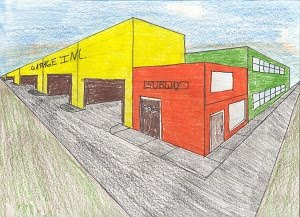Perspective or Linear Drawing is a geometric method of representing on paper the way that objects appear to get smaller and closer together, the further away they are. The invention of linear perspective is generally attributed to the Florentine architect Brunelleschi, and the ideas continued to be developed and used by Renaissance artists, notably Piero Della Francesca and Andrea Mantegna. The first book to include a treatise on Perspective, “On Painting” or Della Pittura was published by Leon Battista Alberti in 1436. It is actually the first modern treatise on the theory of painting. Architects are very familiar with this I’m sure.
Linear Perspective is the apparent diminishing of scale as the distance from object to viewer increases. Each set of horizontal lines has its own vanishing point. For simplicity, artists usually focus on correctly rendering one, two or three vanishing points.
Any perspective representation of a scene that includes parallel lines has one or more vanishing points in a perspective drawing. Perspectives consisting of many parallel lines are observed most often when drawing architecture (architecture frequently uses lines parallel to the x, y, and z axes). Because it is rare to have a scene consisting solely of lines parallel to the three Cartesian axes (x, y, and z), it is rare to see perspectives in practice with only one, two, or three vanishing points; even a simple house frequently has a peaked roof which results in a minimum of six sets of parallel lines, in turn corresponding to up to six vanishing points.
In contrast, natural scenes often do not have any sets of parallel lines. Such a perspective would thus have no vanishing points. For purposes of our discussion, we shall deal with the two basic perspectives: one-point and two-point perspectives.
Single- or One--Point Perspective
The picture on the left (receding railroad tracks) is one best illustration of a single-point perspective. Looking along very straight railroad, the trees, the rails diminishes towards a single spot ahead. In one-point perspective, objects must be placed so that the front sides are parallel to the picture plane, with the side edges diminishing to a single point (one vanishing point).
Take a look at Da Vinci's “Study for Adoration of the Magi” to see the effect. (notice how the building is placed so that it faces the viewer, with the stairs and side walls receding towards a single point in the center.) This perspective is the simplest method of making things look 3-d!!! It is often used for interior views or “trick-the-eye” (trompe l'oeil) effects. Linear perspective allows artists to trick the eye into seeing depth on a flat surface.
Two-Point Perspective
Two-point perspective is slightly more complex. The front and back edges, and side edges, of an object must be diminished towards vanishing points. Two-point perspective is often used when drawing buildings in the landscape. Two-point perspective is useful to show an angle rather than face-on. The effect can be carried even further, with three-point perspective used to create impressive visual effects, such as a view from a skyscraper.
An understanding of perspective drawing is important no matter what subject you choose. We shall have drawing exercises next so get ready with your whiteboards. It’s going to be fun! Say something nice to someone today and God bless :)





